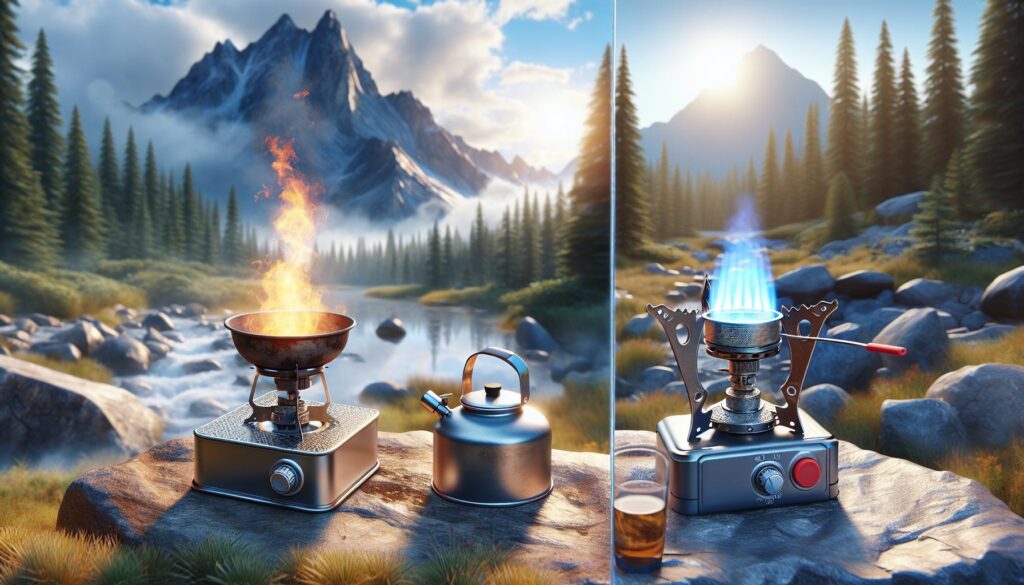When comparing canister stoves vs. liquid fuel, it is important to consider the duration of the trip and the amount of cooking required. There are two main fuel options to choose from: canister fuel and liquid fuel. Each has its own advantages and disadvantages, so it’s important to consider factors such as fuel options, weight, and cost when selecting a stove for your outdoor adventures.
Canister fuel is lightweight and easy to carry, making it a great choice for backpackers looking to save weight and space. It is also convenient and quick to set up, providing a consistent flame. However, canister fuel may have reduced performance at high altitudes and low temperatures, and depressurization can occur in cold weather, causing the stove to stop working. Additionally, canisters may not be readily available in remote areas.
Liquid fuel is cost-effective in the long run and works well at high altitudes and low temperatures. It can be easily refueled without replacing canisters and is compatible with a wide range of stove models. However, liquid fuel requires maintenance and careful handling, and can be heavier and bulkier to carry. It also needs a separate fuel bottle and may take longer to set up and ignite.
Overall, the best choice between canister and liquid fuel stoves depends on individual camping needs and preferences. Canister stoves are ideal for short trips with minimal cooking needs, while liquid fuel stoves are recommended for longer trips or frequent stove usage.
Canister stoves and liquid fuel stoves are both popular choices for outdoor cooking, but they have different advantages and disadvantages. When deciding which stove to use, it is important to consider factors such as weight, performance at high altitudes and low temperatures, cost, safety, maintenance, and accessibility. When it comes to weight, canister stoves are generally lighter and more compact, making them ideal for backpacking and camping trips where weight is a crucial factor. However, liquid fuel stoves tend to be heavier and bulkier due to the need to carry a fuel bottle along with the stove. In terms of performance, canister stoves may struggle at high altitudes and low temperatures due to the depressurization of fuel canisters. On the other hand, liquid fuel stoves perform better in cold weather conditions as they are not affected by temperature variations. When it comes to cost, canister stoves are a cost-effective option for short trips with minimal cooking needs. However, for longer trips or frequent stove use, carrying a large bottle of liquid fuel is more economical in terms of weight and fuel costs. Safety is an important factor to consider when choosing a stove. Canister stoves require proper handling and storage of fuel canisters, while liquid fuel stoves require extra precautions due to the nature of the fuel. In terms of maintenance and durability, both canister stoves and liquid fuel stoves are designed to be durable and withstand outdoor conditions. However, liquid fuel stoves may require more maintenance and care due to the complexity of the fuel system. Finally, accessibility and availability are important factors to consider when choosing a stove. Canister stoves are widely available and easy to find, while liquid fuel stoves may require more effort to find and purchase. In conclusion, both canister stoves and liquid fuel stoves have their own advantages and disadvantages. It is important to consider all factors before making a decision, and choose the stove that best fits your specific needs and outdoor activities. When it comes to the debate of canister stove vs liquid fuel, accessibility and availability are key factors to consider. Canister stoves are better for short trips with minimal cooking needs, while liquid fuel stoves are more suitable for longer trips and heavy stove usage. While canister stoves are lightweight, the need for carrying a large bottle of fuel may offset the weight advantage.It’s important to consider the availability of fuel in different regions, as well as your individual camping and backpacking needs, when selecting a stove for your backpacking or camping trips. Research and plan accordingly to ensure you have a reliable fuel source throughout your adventure.
When deciding between a canister stove and a liquid fuel stove, it is important to consider the specific needs of your trip. Canister stoves are great for short trips that require minimal cooking, while liquid fuel stoves are better suited for longer trips or when more cooking is necessary.
To help you make the best decision, here is a comparison of the two types of stoves:
| Canister Stove | Liquid Fuel Stove |
|---|---|
| Lightweight and convenient | Heavy and cumbersome |
| More expensive overall | Cheaper fuel |
| Easy to use | More complicated and time-consuming |
| Performance issues at high altitudes and low temperatures | No performance issues |
Overall, the choice between canister stoves and liquid fuel stoves depends on the specific requirements of your outdoor adventure. Canister stoves are great for short trips that require minimal cooking, while liquid fuel stoves are better suited for longer trips or when more cooking is necessary.
Are you trying to decide between a canister stove and a liquid fuel stove for your next outdoor adventure? It’s important to consider the specific needs of your trip before making a decision.
Canister stoves are great for short trips that require minimal cooking, as they are lightweight and convenient. However, they can be more expensive overall and may experience performance issues at high altitudes and low temperatures. On the other hand, liquid fuel stoves are heavier and more cumbersome, but the fuel is cheaper and they have no performance issues.
To help you make the best decision, here is a summary of the advantages and disadvantages of each type of stove:
| Canister Stove | Liquid Fuel Stove |
|---|---|
| Lightweight and convenient | Heavy and cumbersome |
| More expensive overall | Cheaper fuel |
| Easy to use | More complicated and time-consuming |
| Performance issues at high altitudes and low temperatures | No performance issues |
Ultimately, the choice between canister stoves and liquid fuel stoves depends on the specific requirements of your outdoor adventure. Canister stoves are great for short trips that require minimal cooking, while liquid fuel stoves are better suited for longer trips or when more cooking is necessary.














